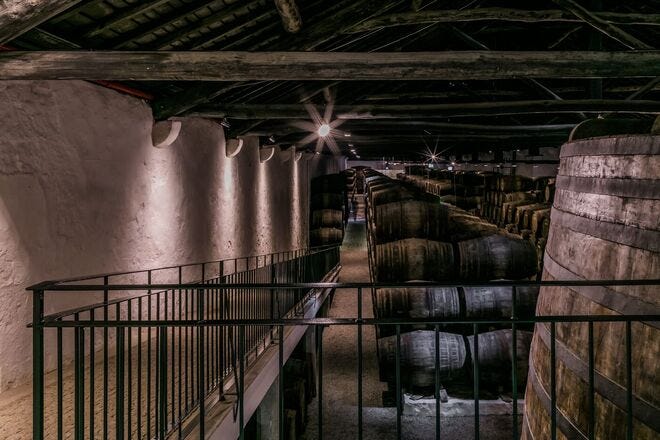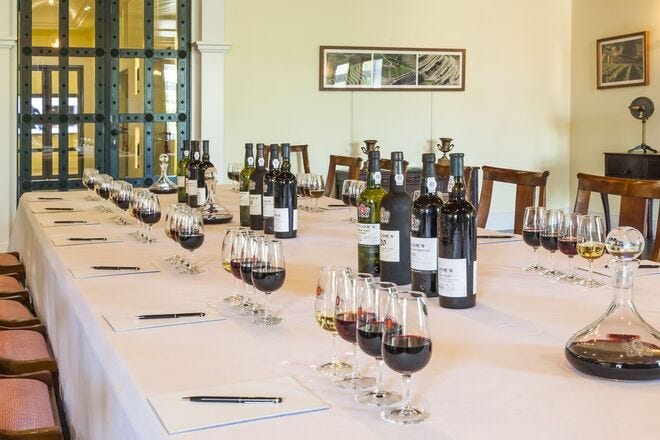Discover why port is gaining popularity and becoming a symbol of an aspirational lifestyle
 Authentic port wine is from Portugal’s Douro Valley — Photo courtesy of Barmalini / Getty Images
Authentic port wine is from Portugal’s Douro Valley — Photo courtesy of Barmalini / Getty Images
If you associate port wine with your grandfather’s nightcap, you aren’t alone. However, the fortified red wine from Portugal is starting to enter the younger mainstream, slowly becoming a symbol of an aspirational lifestyle.
But what exactly is port wine? As the drink gains popularity, here are eight things you probably didn’t know about it.
Port is made in Portugal’s Douro Valley.
 The steep hills of the Douro Valley where port is produced — Photo courtesy of Fladgate Partnership
The steep hills of the Douro Valley where port is produced — Photo courtesy of Fladgate Partnership
Just like real Champagne must be made in the northeastern region of France of the same name, authentic port wine must come from Portugal’s Douro Valley. In fact, the name “port” is derived from the coastal Portuguese city of Porto.
Vote Now: Best Wine Region (10Best Readers’ Choice Awards 2023)
Douro Valley, which sits in northern Portugal, was demarcated as a wine region in 1756, making it the oldest demarcated wine region in the world. It’s also a UNESCO World Heritage site and has been home to winemaking practices for over 2,000 years, since Roman times.
The main difference to regular wine is that port wine is fortified.
 Aging port can take place in wood or in bottles — Photo courtesy of Fladgate Partnership
Aging port can take place in wood or in bottles — Photo courtesy of Fladgate Partnership
Port is a fortified wine, and the only fortified wine made from red grapes. (Sherry, for example, is made with white grapes.) What it means for a wine to be fortified is that a distilled grape spirit (usually a type of brandy) is added during fermentation. This effectively ends the fermentation process before all the sugars are converted to alcohol, making it both sweeter than regular wine and more alcoholic.
Port wine tends to be aged, either in a bottle or a wood cask. These different techniques affect the final flavor and style of the port wine. Full-bodied red ports — like ruby, reserve, and late-bottled vintage port (LBV) — are aged in oak for two, three, and six years, respectively. Mellow tawny ports are produced in decades, aging in wood anywhere between 10 and 40 years.
There are a variety of styles of port, including red, white, and rosé.
 There’s a wide variety of port wines — Photo courtesy of Maksym Kaharlytskyi / Getty Images
There’s a wide variety of port wines — Photo courtesy of Maksym Kaharlytskyi / Getty Images
Red ports — such as vintage port, LBV, crusted port, and ruby port — are honey-sweet with notes of plum, caramel, and chocolate. Tawny ports have more nutty and caramel notes (as well as a brownish color), and rosé ports (the only unaged ports) are fruity, with notes of cherry and strawberry. White port is derived from white Rabigato and Malvasia grapes and is lighter, with a less syrupy consistency and brighter notes of citrus.
Port is often still made the old-fashioned way.
Many vines in the Douro Valley are over 100 years old, and wine-making practices haven’t changed much in that time. Grapes are still handpicked due to the unique topography of the steep, narrow, and trellised vineyards, and many port houses still use the foot-treading method. In other words, wine is still made by physically stomping the grapes to extract the juices after harvest.
Vote Now: Best New Winery Experience (10Best Readers’ Choice Awards 2023)
While expensive and laborious, this technique is “vital to the making of top-quality port,” explains Adrian Bridge, CEO of the Fladgate Partnership, a company known for its port brands, including Taylor’s, Fonseca, Croft, and Krohn. “It is the best way to achieve gentle but complete extraction, producing wines with structure, depth of flavor, and balance.”
There are a variety of ways to enjoy port besides as a dessert wine.
 There are different styles of port, including ruby, tawny, vintage, LBV, crusted, white and rosé — Photo courtesy of Fladgate Partnership
There are different styles of port, including ruby, tawny, vintage, LBV, crusted, white and rosé — Photo courtesy of Fladgate Partnership
Though port wine is thought of as a digestif or a dessert wine and is typically served with cheese after dinner, there are a number of ways to appreciate this fortified wine and all its nuanced flavors. Similar to regular wine, different styles of port complement certain dishes.
“A young vintage is great with a steak, and a 20-year-old tawny chilled as an aperitif or with foie gras is amazing,” says Bridge on his favorite pairings. He adds that lighter-style ports can also be enjoyed without food and make great apéritifs and happy hour drinks. He suggests trying a dry white port on the rocks with an orange twist or a rosé port with tonic.
It’s still a royal family fave.
The English have had a taste for port since 1386 when the Treaty of Windsor established a commercial alliance between England and Portugal. According to Bridge, “The Royal British Family, in their official receptions at Windsor and Buckingham palaces, traditionally toast at the end of the meals with port wine.” Additionally, King Charles III in his first state banquet as king served a 1983 Taylor Fladgate in celebration of visiting South African president Cyril Ramaphosa.


